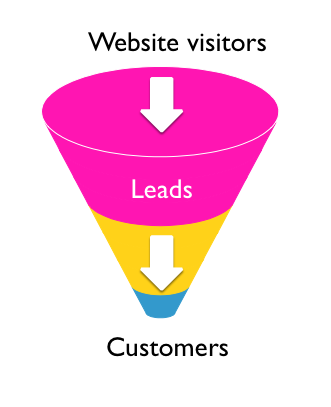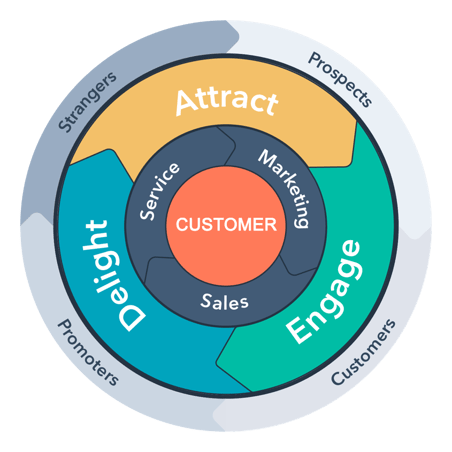If you work in sales or marketing, you are probably used to thinking of your sales process as a funnel. You have a certain number of people who know your business, a smaller number of people who get involved with your business, and an even smaller number of people who are actually customers.
Reevaluating the sales funnel and letting customers create customers
For a long time, a funnel has been used to illustrate this model. It symbolizes how you start with a large volume of potential customers, and move them through a process in order to have a few come out the other end as customers. It’s a recognizable model that makes the process easy to understand. But it also has its weaknesses.
Sales funnel is focused on top
The sales funnel model focuses a lot of time on getting new people into your sales process at the top of the funnel. And most of them never get to the bottom of your funnel. It is a very wasted effort.

The old model focused on sales funnel.
Also, when you pour things into a funnel, the stuff at the bottom does not have much effect on the stuff at the top. But in business, the people who come out of your company's funnel can have a huge impact on the people who come in at the top of it. If your customers love your business and love your product, they will recommend you to their contacts — which means the bottom of the funnel will feed the top of the funnel.
The fact is that many B2B companies list contacts and verbal recommendations as the main source of leads and new customers. (For example, The 5 best sources of b2b leads).
In addition, if your customers have a bad experience, if they are dissatisfied with how you treated them, they will also tell their contacts about it. This means that the people who come out of the funnel can prevent others from entering the top of the funnel.
This is something that we marketers and business leaders need to be aware of and take into account. The attitude of people when they come out of your funnel directly affects the number of people who are willing to enter the top of your funnel.
A circular model for customer acquisitions
That being said, the traditional sales funnel is not the most accurate model to illustrate the customer acquisition process. A more cyclical model, like a wheel, creates a better understanding of the process.
Why does it matter how we illustrate the process? Consider that the model you choose to represent your process shapes how your organization plans and carries out activities and how they are prioritized.
A spinning wheel stores rotational energy. Add power, and it spins faster. Friction is required to slow down the wheel. Unlike a funnel, where the only way to maintain a constant flow is to keep adding things to it, a wheel will continue to spin unless there is enough friction to slow it down.
A company's growth could thus be illustrated by the rotation of the wheel. Satisfied customers provide the power that drives that growth, either because they buy from you again or because they bring new customers to you by marketing your product to other people in their network.
But if you produce dissatisfied customers, either by selling to people who do not fit your offer or otherwise, they will increase the friction for the wheel and slow down your company's growth. So if you want to increase the growth of your business, increase the power of rotation and reduce friction.
The Flywheel: Brian Halligan, one of the founders of Hubspot, introduced the inbound flywheel at the Inbound 2018 conference. The model replaces the traditional sales funnel and more clearly illustrates today's cyclical approach.
Empower your entire team
The power to spin the flywheel comes from your sales team, from marketing, customer recommendations, and of course, fantastic products and services. Friction, we can call everything that slows down sales. It can be internal clumsy processes, substandard customer experiences in the form of products and services.
Most companies and sales teams have no problem adding power. Sellers are driven to move forward, to get things done. It is part of the job to meet quotas and reach goals. Sales leaders add power through increased investments in, for example, marketing and personnel. But chances are, you are already doing your utmost to add power. How many more sales calls or visits per day can the salespeople make?
Focusing on minimizing friction instead is a more effective effort for most companies. A quest for a more frictionless process (both for sellers and buyers!) will more quickly lead to an increased result. Competitive advantages have always developed out of the customer's desire for convenience and the most practical experience.
Embrace the customer experience
This is a potential for improvement that is underdeveloped in many B2B companies. We have complex products and sophisticated pricing. We need our sales teams to play a critical role in the buying process. Suppliers in B2C have done a much better job and embraced the spirit of the times and focused on creating a more seamless customer experience. The manufacturing industry has been thinking about this for decades with Lean Manufacturing.
But this extra complexity makes it even more important for B2B companies to eliminate friction from their sales process. Making it easier for prospects to find the information they need and minimizing friction in the buying process is and will continue to be an increasingly important competitive advantage.
So it's time to do things differently. It is time to reconsider old methods and processes. The B2B companies of the future are among those that satisfy the modern buyer and create a more friction-free sales process.

